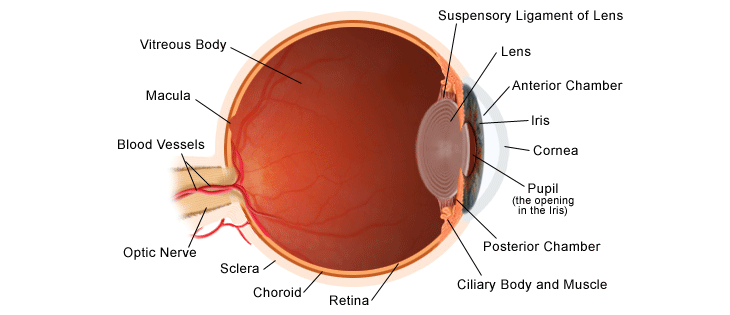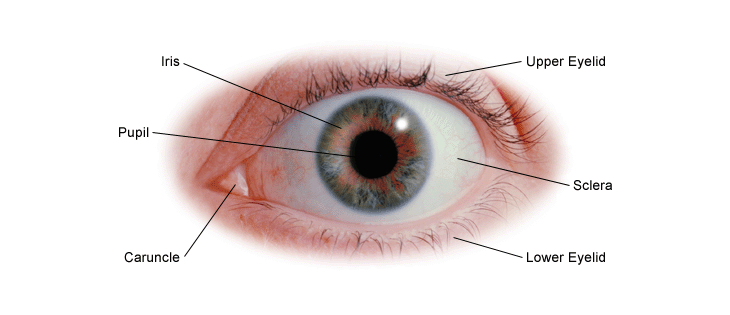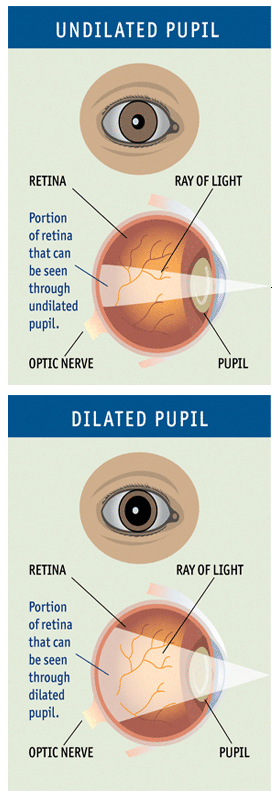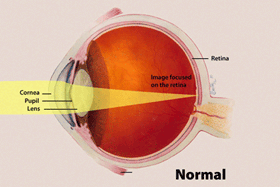Eye Health: General Information
Key Facts
- Get your eyes checked regularly–every year if you wear glasses or contact lenses and every 1-3 years if you don’t.
- Protect your eyes from the sun, injury, chemicals, with sunglasses and safety goggles.
- Prevent eye infections by washing your hands regularly, avoid touching your eyes, keeping contact lenses clean, changing eye makeup regularly, and using clean towels to wipe your eyes.
 Eye health is about:
Eye health is about:
- Getting your vision screen by your primary care provider or an eye health specialist.
- Protecting your eyes during sports and other activities that could cause damage to your eyes
- Getting early treatment for any injury to your eye(s)
- Seeing an eye specialist if you have certain eye conditions such as dry or itchy eyes
Have you ever thought about what’s inside your eyes? Your eyes have many parts working together to create the images you see.

Let’s follow light as it enters your eye to understand how the eye works.
- The cornea is the eye’s clear surface and what light first hits. The cornea bends light and sends it through the pupil.
- The pupil is an opening that gets bigger or smaller. The colored part of your eye, the iris, controls the pupil’s size.
- The lens focuses the light onto the back of the eye (retina).
- The retina contains special cells (photoreceptors) that change light into signals.
- The optic nerve receives signals from the retina and passes it to the brain. The brain uses these signals to create a picture of what you see.

Other cool facts about your eyes:
- Your eyes are filled with a jelly-like stuff called vitreous gel that gives your eyes their round shape.
- The pupil (opening in your eye) gets larger when it’s dark to let in more light.
- Muscles inside your eye can move your eyeball in almost any direction. That way you don’t have to move your head to see what’s out of the corner of your eye.
- Iris (colored part of your eye) means “rainbow” in Greek. Even though the iris can be hazel, green, grey, blue, or brown, only one pigment is responsible for creating the iris’ color – it’s called melanin.
Eye Exam and Vision Testing
The American Academy of Pediatrics and the American Academy of Ophthalmologists (2 groups of medical experts) recommend that children and teens should have their eyes checked every 1-3 years. Your primary care provider will check your vision at your yearly checkup. Some schools also do vision testing. You will be referred to an eye specialist for more testing if necessary. If you wear glasses or contact lenses, you should see an eye specialist once a year (or more often if you have an eye condition).
What’s the difference between vision testing and an eye exam?
Vision testing tells how well you can see, usually by having you read a chart with letters or symbols of different sizes. This is also called an acuity test. The test helps the eye specialist figure out if you need glasses or contacts to improve your vision. A full eye exam usually takes longer since it tests not only your vision, but other parts of your eyes as well.
What happens during an eye exam?
During an eye exam, the eye specialist performs tests to make sure your eyes are healthy. You may have a full eye exam or just a few tests, depending on what he/she thinks you need. Eye exams aren’t usually painful, but your eyes may feel a little irritated after the testing.
- Dilation: The eye specialist may put drops in your eyes to dilate your pupils, which makes them bigger for a little while. It takes about 10-20 minutes for the medicine to work. Your eye specialist will then be able to look at the back of your eyes (called the retina), to check for any problems.
- Pressure: The eye specialist may put the tip of an instrument called a tonometer near your eye. You will feel a quick puff of air. This tests the pressure of your eyes, which is also called tonometry, and is a test for glaucoma.
- Side vision: The eye specialist will ask you to look up, down, right, and left while shining a light in your eyes. This test is done to check the movement of your eyes in different positions of gaze.
- Peripheral vision: This test is done to check how far up and down or side to side you can see while looking straight ahead and how sensitive your vision is in different parts of the visual field. Your eye specialist or eye technician may do this manually by holding a finger or object in your peripheral vision (while you look straight ahead) or using a special machine that flashes light in your visual field.
- Reflex: The eye specialist shines a small light in your eyes to see how the light is reflected on the cornea (front of the eye). The test is normal if the reflection is at the center of the pupils (eye opening).
- Cover test: The eye specialist will place an eye paddle on one eye and then the other to assess if your eyes are straight or crossing.

How often should I have my eyes checked?
You should visit your primary care provider (PCP) every year for a well checkup and if indicated, vision testing.
You should see your PCP if you’re having problems with your eyes, such as:
- Blurry vision
- Seeing double
- Redness
- Swelling
- Light bothering your eyes
- Tearing
- Squinting
- Itchy eyes – needing to rub your eyes often
- Trouble reading
- Trouble seeing the chalkboard at school
- Headaches
*Sometimes eye symptoms such as redness and itchiness of the eye can be caused from allergies.
Why would I need to get my eyes checked more often than my friends?
Some diseases, injuries, or infections can affect the health of your eyes.
Your PCP may want you to have your eyes checked more often if you have any of these problems:
- Past or current eye injury
- Eye infection
- Changes in vision
- Diabetes
- Juvenile rheumatoid arthritis
- Crohn’s disease
- Or if other people in your family have eye diseases or conditions such as glaucoma, strabismus (eye crossing) or they wear glasses.
My eyes water all the time; is this normal?
Having occasional tearing is common, but if your eyes water all the time it’s best to see your primary care provider. The most common cause of tearing is dry eye, allergies, or infection.
Is eye makeup bad?
Eye makeup can be safe when used properly. Here are some tips for keeping your eyes healthy while wearing eye makeup.
- Change your eye makeup (mascara and liner) after 4-6 months to prevent infections, but if you get an infection, throw out all your eye makeup and replace it.
- Don’t share makeup or use makeup samples at the store.
- Test one new eye makeup at a time to see if you’re allergic.
- Avoid glittery or metallic makeup that can irritate your eyes.
- Don’t put makeup on while you’re driving.
- Make sure your face is clean before you apply makeup.
- Don’t get makeup too close to the lash line.
- Don’t put any sharp or pointed objects near your eyes.
- Remove eye makeup before bed.
- Try not to get makeup remover in your eyes and wash it off thoroughly.
Is it safe to get my eyelids tattooed?
Eyelid tattoos can be very dangerous because of the tattoo’s closeness to the eyes. When a person gets an eyelid tattoo, ink is injected by a needle into the eyelid, puncturing the skin between 500-3000 times per minute. Risks include infection, an allergic reaction to the ink, and the needle could pierce the eye and cause blindness or other serious eye problems.
Most states require you to get your parents’ permission to get any type of tattoo if you are under 18. No matter what age you are, talk about it with your parents or a trusted adult before making a quick decision. If you understand all of the risks and have talked to a parent or guardian, and you still want to tattoo your eyelids, be sure to find a professional, experienced tattoo artist who uses only sterile equipment and has a clean studio. This is true before getting any tattoo for any part of your body.
Is it safe to get my eyebrow pierced?
Since the eyebrow is very close to the eyes, there are many possible risks to getting piercing in this area. Talk to a parent, guardian, or trusted adult. If you decide to get a piercing after doing your research and getting your parents’ permission as well as knowing the risks involved, make sure to go to an experienced piercer that uses sterile equipment. A piercing gun should never be used because it can damage tissue and cause infection.
Can you get an STI in your eye?
You could potentially get an STI in your eye if you or your partner touch an infected part of your genitals or anus and then touch or rub your eye(s) carrying bacteria to the eye. For example, if chlamydia infects the eye, it’s called chlamydial conjunctivitis and if gonorrhea infects the eye, it’s called gonococcal conjunctivitis.
 The cornea and lens bend the incoming light so that the image is focused on the retina, which is located at the back of the eye. (See image)
The cornea and lens bend the incoming light so that the image is focused on the retina, which is located at the back of the eye. (See image)